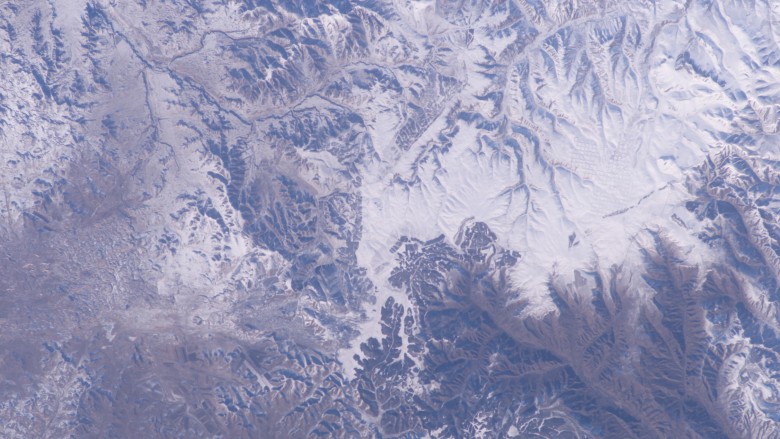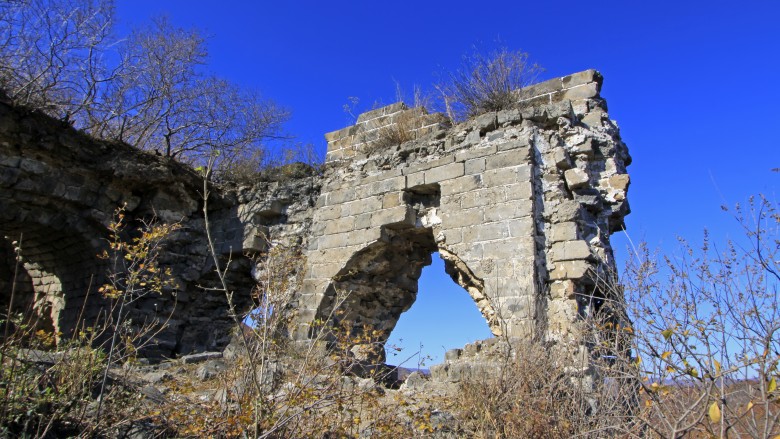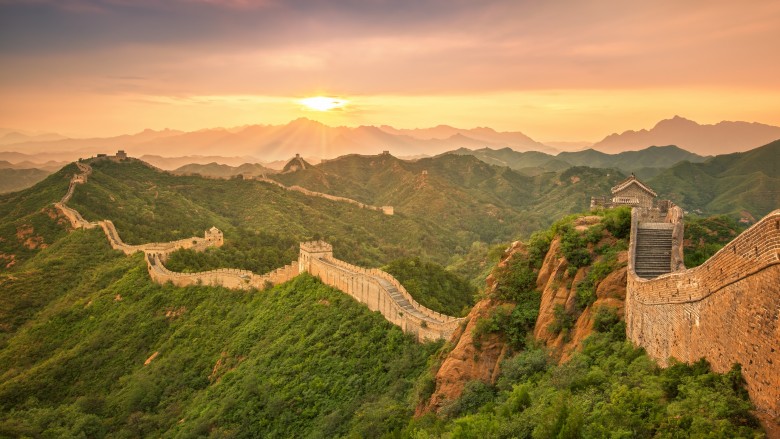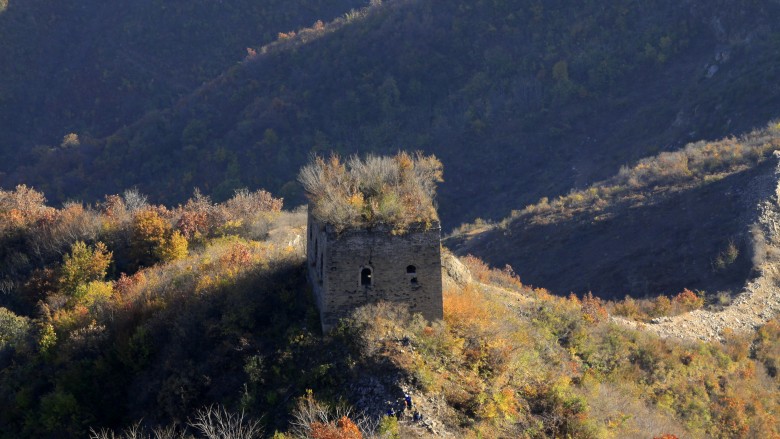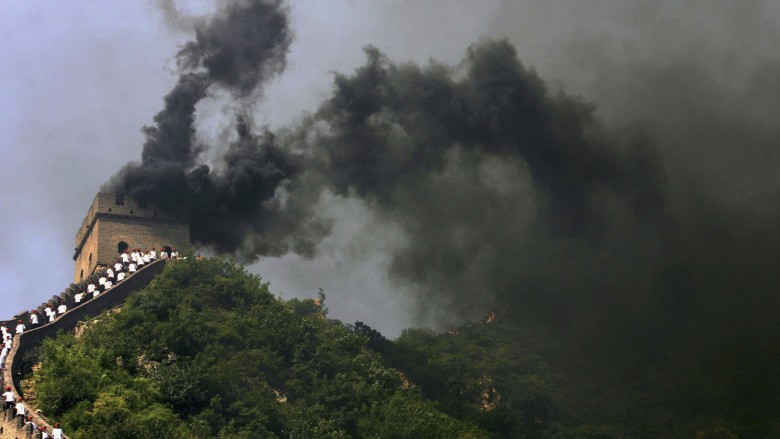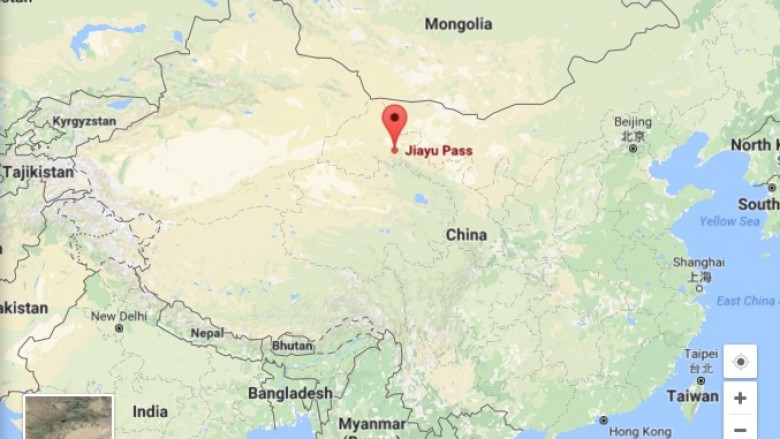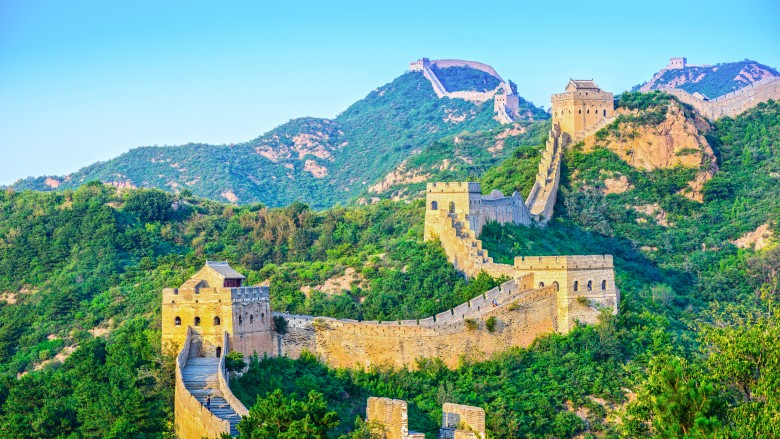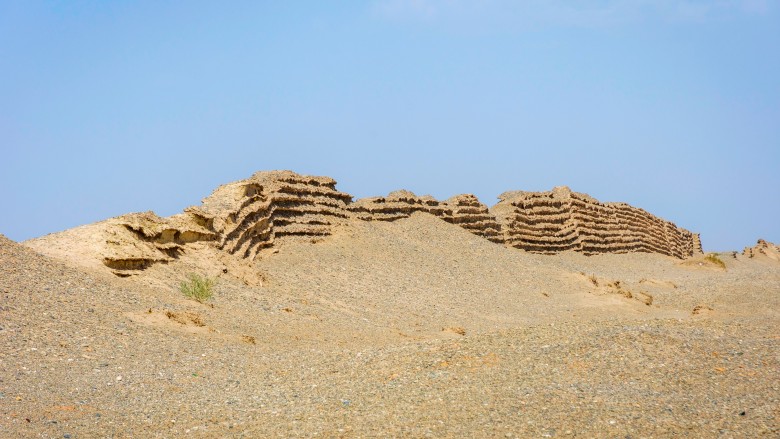False Facts About The Great Wall Of China You Always Thought Were True
It's a colossal mass so big it stretches across international time zones. A collection of matter so unimaginably huge tourists from round the world flock to see it. Yup, yo momma's waistline is impressive, all right. But it's got nothing on the Great Wall of China. One of the greatest construction projects ever undertaken, the Wall is a Chinese icon – maybe the Chinese icon. A UNESCO World Heritage site, its history, and its facts, are known to millions of humans around the world. Too bad most of the facts we think we know about it are wrong, wrong, and wrong.
False: It's the only man-made structure visible from space
What's the one, stand-out fact you remember hearing about the Great Wall as a kid? We're gonna hazard a guess and say "that it's the only man-made structure visible from space" (or, in some versions, the Moon). It sure sounds true: at 4,500 miles (7,200 km), the Wall is one of the biggest darn things ever built. But the only man-made structure visible from space? We hate to break it to ya, buddy, there are tons of man-made structures visible from the realm of Almighty Zeus. And guess what? The Great Wall ain't one of them.
See, while the Wall sure as heck is long, it's also pretty narrow. Its maximum width is 20 feet, making it no more visible from above than your average stream. On top of that, it's not very colorful. The majority of the Wall is a mixture of sandstone and clay, and it turns out that this is a major disadvantage when hoping to wow extraterrestrials. As NASA space shuttle pilot Jeffery Hoffman explained: "The problem is that the human eye is most sensitive to contrast, and the color of the wall is not that different from the ground on either side of it." So, while it's pretty easy to identify dark, desert-crossing highways from space, the Great Wall just kinda blends into the background.
The origin of this legend was a Ripley's Believe It or Not! comic from 1932, and it turns out the emphasis should have firmly been on the Not!. Yet the story somehow caught on, to the extent that one of the first things Neil Armstrong was asked on returning to Earth was if he could see the Wall from the Moon.
False: It's continuous
Plenty of us dream about doing a trip-of-a-lifetime walk along the length of the Great Wall. Plenty of us are doomed to be disappointed. Such a dream is even less likely to come true than that one you keep having about the Dallas Cowboys cheerleaders. Despite what postcards suggest, the Great Wall wasn't designed to be walked on. Outside of a very, very small area near Beijing, it doesn't have an accessible top. But even if it did, you'd still be outta luck. The Great Wall is discontinuous. That means that there are gigantic holes in it so big even yo momma could fit through (sorry).
This isn't due to neglect. The Great Wall was never designed to be a single structure. A more accurate name for it might be the Great Walls. The 'Wall' consists of a series of walls, mud banks, earthen mounds, bedrock and lakes that, taken together, form a difficult-to-cross barrier. But even then, it doesn't totally join up. There are empty stretches big enough to ride an entire Mongol horde through, provided you have the time and horses and unquenchable bloodthirst necessary for doing so.
Part of a reason for the Wall's discontinuous nature is historic. When construction started, there were already several defensive walls in newly united China, so it made more sense to just haphazardly join them up and save on materials. Sorta like how you stitched your last English lit essay together from all those other essays that already existed online, only not like that at all.
False: It's really old
When Emperor Qin Shi Huang ordered the construction of the Great Wall, Jesus was still over 200 years away from being born. Julius Caesar wouldn't invent the Caesar salad for another century. There are global religions younger than the Wall ... or, at least, on paper there are. But the actual, physical Wall? The one you see in tourist brochures and wistful Google Image searches? That's really not so old. We're talking 500 years, maximum.
Pretty much every part of the modern Great Wall was built by the Ming Dynasty, with the finishing touches not going on until the 17th century. The original, Qin-built Wall had been nothing more than earthen mounds, most of which had long eroded away by the time the Ming showed up. An overhaul was needed to keep the 'Wall' part of the Great Wall's name from sounding ironic. So the Ming got to work, building over the ruined original to make the Wall we all know today.
Wait, did we say "building over the ruined original"? Whoops. Turns out a whole lot of other, pre-Ming dynasties had already done just that. After the fall of the Qin Dynasty in 210 BC, the Wall fell into disrepair. It was only saved when the Northern Wei Dynasty rebuilt it around AD 386–535. But when the Tang Dynasty took over in 609, the wall fell into ruins for the second time. By the time the Ming came along, they were making a reconstruction of a reconstruction of a reconstruction. Oh, and they used totally different techniques and materials, so the modern Wall looks absolutely nothing like any of the versions that preceded it.
False: It was built to repel the Mongols
Say it ain't so! You mean South Park lied to us? Yep, we couldn't believe it either. The idea that The Great Wall of China was built to keep out the Mongols is absolutely ingrained in popular culture, to the extent that some of you reading this are likely convinced we've got this wrong. Yet there's a very good reason the Wall couldn't have been built to keep the Mongols out. The Mongols wouldn't exist as a unified race until 1,000 years after construction started.
For the Qin, the real worry was nomadic tribes. During their short-lived dynasty, it was fear of the Xiongu that led to the Wall's initial construction. As time rolled on, the Juan-juan and Khitan tribes replaced the Xiongu as the Chinese boogeymen, followed even later by the Tujue. Those guys, by the way, weren't even ethnically Mongolian. They were Turkic.
Even if you were just to (inaccurately) lump all these nomads under the umbrella term "Mongols," it would still leave out one important people the Wall was designed to keep out: the Chinese. When the victorious Qin started connecting leftover fortifications from the Warring States Period into the Great Wall, they were using walls that had specifically been built by other Chinese states to keep the Qin out. There's a juicy historical irony for you.
False: It worked
When you build a Wall over 4,000 miles long, the least you can expect is for it to keep some pesky nomadic raiders out. Yet the Great Wall failed to manage even this. From its earliest days as a load of earthen mounds under the Qin, to its final bricks-and-mortar form under the Ming Dynasty, the Wall utterly sucked at keeping other human beings out of Imperial China.
If you need an illustration of this, look no further than the Mongol warriors. Their Yuan Dynasty (1271–1368) didn't just overrun the Wall and take over the whole of China. They then used the Wall as their own defensive line, protecting other Mongol caravans and traders from counterattack. We like to think the overthrown rulers of the Song Dynasty spent their last, agonizing moments on Earth appreciating this amusing irony.
At other times, the Wall's defensive failures were less dramatic, but still notable. One of its primary purposes in the Ming Dynasty was to block the influx of nomadic traders and separate the Han from their supposed racial inferiors. Only it turned out the Han Chinese manning the Wall in the north weren't too bothered by nomads. They were too far from the Empire's heart. Too lonely. Too desperate to shack up with some Mongolian girls. So they just kinda let their neighbors across for trading, and then marriage, and the border just ceased to exist in any practical sense.
False: It's been protected for centuries
When you've got a tourist draw and historic masterpiece like the Great Wall, you're gonna want to protect it. Sure enough, just like Britain protects Stonehenge and the US protects Yellowstone Park, China legally protects the Great Wall. But while Stonehenge has been protected since 1884, and Yellowstone since 1872, China's been a bit of a laggard with affording their national treasure protection. Before a new law came into effect in 2003, Chinese rulers used to actively encourage people to vandalize the Great Wall.
The worst offender was (surprise!) Chairman Mao. During the Cultural Revolution, Mao's Communist Party told ordinary people to tear down chunks of Wall and use its bricks to build their homes. Huge swaths became open quarries, with the material ending up in everything from houses, to garden walls, to pigsties.
But at least Mao had the excuse of being a stark-raving bonkers dictator. The private companies that moved in during the '90s were just desperate for cash. As China liberalized, corporations started vandalizing the Wall with gusto. Chunks were knocked down to make way for housing developments. Holes were filled in with unsightly concrete. One company even built go-kart tracks and burger joints on top of one section, hoping to cash in on the tourist demand to see cultural desecration happen in real time.
It doesn't help that the Wall's preservation budget has often been laughably small. In 2004, the Guardian reported that a typical 100-mile stretch had a mere three men watching over it, with a monthly "preservation" budget equivalent to £150.
False: It covers China's northern border
Despite our romantic notions, the Great Wall doesn't even come close to covering China's northern border. Want to know why? Because China is massive. Huge. Indescribably big. Know what places are bigger than China? Canada, Russia ... and that's it. At 9,572,900 square kilometers, China is even bigger than the US (just. The USA clocks in at 9,525,067). Even so, the sheer amount of territory left unprotected will shock you. The Great Wall officially ends at Jiāyùguān Fort, Jiayu Pass, in Gansu Province. As you can see from that handy map above, Jiayu Pass is nowhere near China's Western border.
Even during the Ming Dynasty, Jiāyùguān was well east of the frontier of Imperial control. While no one might have wanted to live out in the hostile desert wastes beyond it, they were still Chinese hostile desert wastes, and presumably in as much need of protection as the rest of the country.
So where does our wrongheaded notion of the Great Wall's length come from? Probably the same place as our notion that the Wall is one unbroken fortification, or that it all looks like it does in National Geographic photos: from our instinctive romanticizing of the East. We'd rather imagine Imperial China as some pristine and magical, half-forgotten land, than as a creaking bureaucracy whose builders were probably even lazier than ours.
False: It's the first (and only) Great Wall in China
Know what would be a better name for the Great Wall of China? A Great Wall of China.
In 2011, Field Museum of Chicago archaeologist Guy Feinman was taking part in a dig in Shandong Province when he stumbled across something extraordinary. He and his team found an ancient rammed earth wall that stood 15 feet high and unfurled over several hundred miles. It was a forgotten Chinese 'Great Wall' that had predated construction on its famous sibling by 300 years. The craziest part? It wasn't the only one.
During the Warring States period (475–221 BC), the disparate kingdoms that made up China went mad for building gigantic freakin' walls to keep their hostile neighbors out. Feinman's wall was just one of many, many that were trumpeted as 'great' long before the Qin Dynasty decided to claim the word as their own. In 290 BC, the Yan built a monster wall from Zhangjiakou to Liaoyang, covering a distance of nearly 1,000 kilometers. Earlier still, the pre-dynasty Qin and their predecessors (the Qi), built vast walls of equally impossible size.
Sure, the Great Wall was bigger than all of them (it incorporated huge chunks of several rivals), but it couldn't have existed without its trailblazing ancestors. Hmm, maybe we were wrong. Maybe a better title would be the Greatest Wall of China?
False: It's gonna be around forever
When something has survived, in one form or another, for over 2,000 years, it's tempting to assume it will be around forever. Surely after surviving all those earthquakes, floods, civil wars, and catastrophes, the Great Wall has kinda proved itself invincible. And therein lies the problem. That sentence assumes the Wall did, in fact, survive all the many disasters of Chinese history. In reality, nearly a third of it has completely crumbled away.
This adds up to some 2,000 kilometers of the world's biggest heritage site simply lost forever. The freakiest part is that more of it is vanishing every single day. The Great Wall of China Society estimates only 8.2 percent of the remaining Wall is in good condition, with 74.1 percent so poorly preserved that the last thing you'd want to do is stand beside it during an earthquake or Black Sabbath revival gig. While the Communist Party has recently pulled its act together with preservation, destruction caused by jaw-dropping dumbness still occurs. In 2015, the local government in Ningxia bulldozed a chunk of Wall to make room for farms. Worse still are the tourists. In 2016, China announced it was cracking down on visitors stealing bricks from or leaving graffiti on the Great Wall.
On top of all this, regions of the Wall out in the deserts to the west have been eroded away by sandstorms, leaving whole stretches in disrepair (as you can see above). Unless someone starts pumping some serious money in soon, we'll reach a point where only a tiny, well-preserved section of the Great Wall is left outside Beijing and the rest is just ruins. In other words, now might be the perfect time to book that once-in-a-lifetime trip to China, while there's still some Wall left to see. Just don't make off with any bricks while sightseeing, y'hear?

